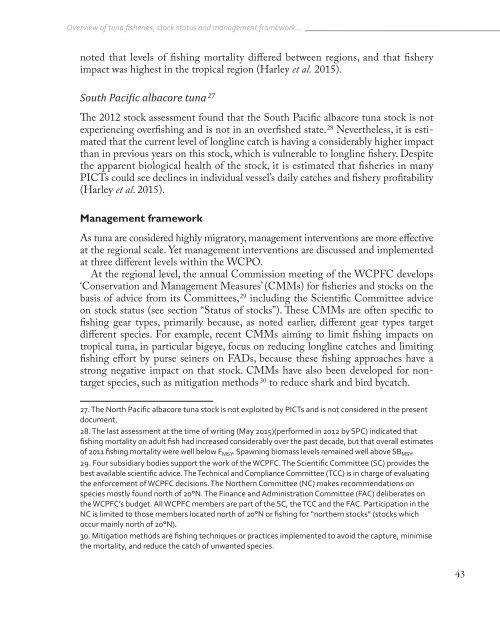Fisheries in the Pacific
Fisheries_in_the_Pacific
Fisheries_in_the_Pacific
Create successful ePaper yourself
Turn your PDF publications into a flip-book with our unique Google optimized e-Paper software.
Overview of tuna fisheries, stock status and management framework…<br />
noted that levels of fish<strong>in</strong>g mortality differed between regions, and that fishery<br />
impact was highest <strong>in</strong> <strong>the</strong> tropical region (Harley et al. 2015).<br />
South <strong>Pacific</strong> albacore tuna 27<br />
The 2012 stock assessment found that <strong>the</strong> South <strong>Pacific</strong> albacore tuna stock is not<br />
experienc<strong>in</strong>g overfish<strong>in</strong>g and is not <strong>in</strong> an overfished state. 28 Never<strong>the</strong>less, it is estimated<br />
that <strong>the</strong> current level of longl<strong>in</strong>e catch is hav<strong>in</strong>g a considerably higher impact<br />
than <strong>in</strong> previous years on this stock, which is vulnerable to longl<strong>in</strong>e fishery. Despite<br />
<strong>the</strong> apparent biological health of <strong>the</strong> stock, it is estimated that fisheries <strong>in</strong> many<br />
PICTs could see decl<strong>in</strong>es <strong>in</strong> <strong>in</strong>dividual vessel’s daily catches and fishery profitability<br />
(Harley et al. 2015).<br />
Management framework<br />
As tuna are considered highly migratory, management <strong>in</strong>terventions are more effective<br />
at <strong>the</strong> regional scale. Yet management <strong>in</strong>terventions are discussed and implemented<br />
at three different levels with<strong>in</strong> <strong>the</strong> WCPO.<br />
At <strong>the</strong> regional level, <strong>the</strong> annual Commission meet<strong>in</strong>g of <strong>the</strong> WCPFC develops<br />
‘Conservation and Management Measures’ (CMMs) for fisheries and stocks on <strong>the</strong><br />
basis of advice from its Committees, 29 <strong>in</strong>clud<strong>in</strong>g <strong>the</strong> Scientific Committee advice<br />
on stock status (see section “Status of stocks”). These CMMs are often specific to<br />
fish<strong>in</strong>g gear types, primarily because, as noted earlier, different gear types target<br />
different species. For example, recent CMMs aim<strong>in</strong>g to limit fish<strong>in</strong>g impacts on<br />
tropical tuna, <strong>in</strong> particular bigeye, focus on reduc<strong>in</strong>g longl<strong>in</strong>e catches and limit<strong>in</strong>g<br />
fish<strong>in</strong>g effort by purse se<strong>in</strong>ers on FADs, because <strong>the</strong>se fish<strong>in</strong>g approaches have a<br />
strong negative impact on that stock. CMMs have also been developed for nontarget<br />
species, such as mitigation methods 30 to reduce shark and bird bycatch.<br />
27. The North <strong>Pacific</strong> albacore tuna stock is not exploited by PICTs and is not considered <strong>in</strong> <strong>the</strong> present<br />
document.<br />
28. The last assessment at <strong>the</strong> time of writ<strong>in</strong>g (May 2015)(performed <strong>in</strong> 2012 by SPC) <strong>in</strong>dicated that<br />
fish<strong>in</strong>g mortality on adult fish had <strong>in</strong>creased considerably over <strong>the</strong> past decade, but that overall estimates<br />
of 2011 fish<strong>in</strong>g mortality were well below F MSY . Spawn<strong>in</strong>g biomass levels rema<strong>in</strong>ed well above SB MSY .<br />
29. Four subsidiary bodies support <strong>the</strong> work of <strong>the</strong> WCPFC. The Scientific Committee (SC) provides <strong>the</strong><br />
best available scientific advice. The Technical and Compliance Committee (TCC) is <strong>in</strong> charge of evaluat<strong>in</strong>g<br />
<strong>the</strong> enforcement of WCPFC decisions. The Nor<strong>the</strong>rn Committee (NC) makes recommendations on<br />
species mostly found north of 20°N. The F<strong>in</strong>ance and Adm<strong>in</strong>istration Committee (FAC) deliberates on<br />
<strong>the</strong> WCPFC’s budget. All WCPFC members are part of <strong>the</strong> SC, <strong>the</strong> TCC and <strong>the</strong> FAC. Participation <strong>in</strong> <strong>the</strong><br />
NC is limited to those members located north of 20°N or fish<strong>in</strong>g for “nor<strong>the</strong>rn stocks” (stocks which<br />
occur ma<strong>in</strong>ly north of 20°N).<br />
30. Mitigation methods are fish<strong>in</strong>g techniques or practices implemented to avoid <strong>the</strong> capture, m<strong>in</strong>imise<br />
<strong>the</strong> mortality, and reduce <strong>the</strong> catch of unwanted species.<br />
43


